By: Michael Palmer
This article was originally published in BBKA News, the newsletter of the British Beekeepers’ Association. Please visit www.bbka.org.uk for more information. This article was reprinted in the Summer 2018 issue of BEEKeeping Your First Three Years.
The beginnings of a new plan
I used to buy bees, lots and lots of bees; singles from South Carolina, nuclei from Florida and frames of brood from New York. I used to buy queens, lots and lots of queens; queens from Georgia, queens from Texas and queens from California. Every year it was the same. Pick up the pieces of my apiary in the Spring, send a big check to southern queen breeders, split up my best colonies, and hope I made enough of a honey crop to pay the bills. Some years I did, some years I did not.
In 1982, an apiary management job became available with a New York state orchard located on the west side of Lake Champlain. Chazy Orchards, advertised as the largest contiguous McIntosh orchard in the world, managed something like 800 acres of trees. Whether or not it was the largest then or is today I do not know, but I can say it was huge to me. The new job added 500 additional colonies to my workload. Colonies more or less dumped in my lap with the instructions, ‘fix it’. The orchard’s apiary had crashed over the years from mismanagement and American foul brood (AFB). What had been a successful apiary of more than 800 colonies had dwindled to 150 by 1980. The orchard was able to hire a former Vermont bee inspector for a couple years and he did a great job of cleaning up the disease and starting the buildup of colony numbers to near pollination requirements.
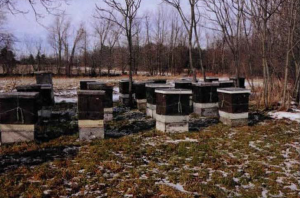 When I took over, the bees were in decent shape but unproductive. There had not been a honey crop in years and the previous beekeeper, while dealing appropriately with the AFB, nearly bankrupted the apiary, costing $55 a colony for his management when the orchard could rent colonies of bees for $22. How many times the owner of the orchard threatened to burn the whole lot I cannot remember, but it seemed like all the time. While working for an angry man is never much fun, I have a thick skin and persisted with my management. The second year I worked for Chazy Orchards, the bees made almost five tons of honey. The angry man almost smiled. The following year we made 10 tons of nice light honey, and management costs fell to less than rental prices.
When I took over, the bees were in decent shape but unproductive. There had not been a honey crop in years and the previous beekeeper, while dealing appropriately with the AFB, nearly bankrupted the apiary, costing $55 a colony for his management when the orchard could rent colonies of bees for $22. How many times the owner of the orchard threatened to burn the whole lot I cannot remember, but it seemed like all the time. While working for an angry man is never much fun, I have a thick skin and persisted with my management. The second year I worked for Chazy Orchards, the bees made almost five tons of honey. The angry man almost smiled. The following year we made 10 tons of nice light honey, and management costs fell to less than rental prices.
After working for the orchard for several years, I was ready to expand my own apiary. I felt I could do better with my own bees, and in 1986 I gave my notice; sell me your bees or I am off to work for myself. The grumpy old man resisted but his son saw the wisdom in my offer and the orchard agreed to sell me the bees and all the related equipment. At the time, I thought I had it made. I now owned a business of more than 800 colonies, pollinated with 600 colonies, and if everything worked out as I hoped, the possibility of making many tons of honey seemed entirely possible. Looking back, I now realize the folly of my new path. The best-laid plans often go astray and I found that to be true.
Beekeeping is just like all other agricultural endeavors. It is a tough way to make a living and it seems that every year something goes wrong. How many times have you said it will all be better next year? Next year your bees will Winter successfully, or they will make a big honey crop because you will do this or that or something else. That is the great hope of every farmer everywhere, no matter what they grow or where they farm. Next year will be the year. So I approached my beekeeping with an eye to the future and the belief that next year will be the year.
Over the years that followed, I did the best job I could. I followed the best management practices recommended by beekeeping experts and educators. My honey crops averaged 18 to 20 tons a year and my Winter losses averaged 10 or 15 percent. For a few years there, in the late 80s, my apiary did me well. Then came Acarapis woodii (Tracheal mites). Winter mortality skyrocketed; losses of 30 to 50 percent became normal. Two years after the arrival of acarine, I discovered Varroa destructor in my bees. On seeing that first mite, I closed the hive, sat down under an ancient sugar maple, to think about what I had just seen. I knew this was the end of an era and of beekeeping as I had known it. I felt a bit like that maple tree that held my back. She had stood on that spot for hundreds of years, watching the passing of the old ways, one by one. She and I were witnessing the passing of another.
The 1990s was a tough time to be a beekeeper. Winter losses were high and Spring clusters were small. As an apple pollinator with a contract to fulfill, I found it difficult to maintain the required number of suitable colonies to pollinate the orchard. Some years, with numbers way down and very few colonies strong enough for Spring splits, I resorted to buying bees. That is where the singles from South Carolina, the nuclei from Florida, and the frames of brood from New York came in. It was mandatory that I fulfill my pollination contract. I had no choice but to buy in replacement bees and pay for them with my pollination check and it went like that for several years. Buy replacement bees in the Spring spending what money I had and hope a decent honey crop would come my way. You all know how fickle the honey crop can be, so this was not a good plan. I felt as if I was slowly losing my business. There really had to be a better way.
In 1999, I visited Kirk Webster, another Vermont beekeeper, just before apple bloom. We drove out to one of his apiaries where he showed me some of his over-wintering nucleus colonies. These nucleus were wintering on top of production hives and there were bee beards hanging from the entrances of the nucleus boxes. Understand I was a struggling beekeeper trying to keep my bees alive and fulfill my pollination contract. This particular Spring was late and it was all I could do to put together 600 good colonies for the orchard and Webster had over-wintered nucs that were so populous they were bearding, two weeks before apple bloom.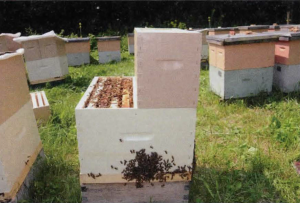
That really got me thinking. My management meant splitting up all the strong colonies I had to keep my numbers up, and spending the money I made on apple pollination to buy bees and queens to help restock my apiaries and Webster had nuclei wintering in his apiaries with bee beards, two weeks before bloom. After seeing those nucleus with bearding bees hanging out their little entrances, in the middle of April, I was convinced. It was time for a management change.
It was not until years later that I realized the full potential of having nuclei wintering in my apiaries. All the bee work I do now, as the owner/manager of a large business, is centered on the production, wintering, and use of nucleus colonies with locally reared queens.
Maintaining honey producing apiaries
For the first few years I wintered nucleus colonies, I thought of them as stocks for replacing Winter losses and as stocks for making increase. Dead colonies were cleaned up and new equipment was readied. Nucleus colonies that had successfully wintered were transferred to the empty equipment and apiaries were filled after the long Winter. Nucleus colonies were perfect for both uses and often built up faster than many of the over-wintered production colonies. In fact, they absolutely exploded on the dandelion flow when hived on drawn comb.
In a commercial honey producing operation, the beekeeper must keep colony numbers up and every colony as strong as possible. While increased numbers may seem beneficial to the honey producer, quantity should never trump quality. Weak colonies do not produce. With that thought in mind, I began managing weak Spring colonies differently. Formerly I had boosted slow colonies with frames of emerging brood from the best colonies. It was a good plan. The weak colony got a shot of young bees and the strong colonies got some needed swarm control. But, did that swarm control come at the cost of a reduced honey crop? With my short beekeeping season, I would have to say yes. And did boosting weak colonies with brood do anything to correct the problem? I had to ask myself why were they weak? Was it the fault of the queen? I believed most likely so and re-queened them later in the season. But why wait? Why not just do it right off when the problem was first discovered. Rather than give a weak colony valuable brood resources only to discover a failing queen later in the Summer, why not just kill that old queen and give the colony an over-wintered nucleus? Doing so immediately boosts that weakling early in the season and requeens it at the same time. It takes a struggling colony with an inferior queen and only three or four frames of brood and turns it into strong colony with a tested queen and eight or nine frames of brood. The results can be startling.
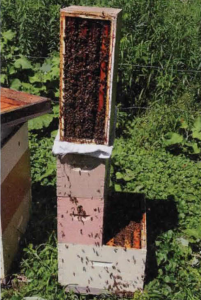 As I said, in the beginning nucleus colonies were future production colonies to be used in my apiary. I made them up before the middle of July, using brood and bees from hives that were not strong enough to make a honey crop. The little colonies would build up, filling their four frame cavities. When August arrived, with hot and humid 90° F weather, it was all I could do to keep them in their boxes. The only solution seemed to be to remove frames of brood and bees, replace them with comb or foundation, and start more nuclei. That worked to some extent, but nucleus colonies made up after the beginning of August do not Winter well here in Vermont. So what to do? I chose to add that excess brood to struggling production colonies. This turned out to be a good use of those resources. Imagine placing a deep body of brood on the floor of a colony having difficulty growing enough of a population to survive the coming Winter. The results were quick and lasting. The larger cluster created by adding combs of emerging brood not only boosted the colony population in the short term, that increased cluster size lasted through the Winter and come Spring, those colonies were among the strongest in the apiary. It was as if I had dropped a bomb on each colony and I jokingly referred to them as ‘Bee Bombs’ in an article I wrote for this magazine. Drop the bomb and the population explodes.
As I said, in the beginning nucleus colonies were future production colonies to be used in my apiary. I made them up before the middle of July, using brood and bees from hives that were not strong enough to make a honey crop. The little colonies would build up, filling their four frame cavities. When August arrived, with hot and humid 90° F weather, it was all I could do to keep them in their boxes. The only solution seemed to be to remove frames of brood and bees, replace them with comb or foundation, and start more nuclei. That worked to some extent, but nucleus colonies made up after the beginning of August do not Winter well here in Vermont. So what to do? I chose to add that excess brood to struggling production colonies. This turned out to be a good use of those resources. Imagine placing a deep body of brood on the floor of a colony having difficulty growing enough of a population to survive the coming Winter. The results were quick and lasting. The larger cluster created by adding combs of emerging brood not only boosted the colony population in the short term, that increased cluster size lasted through the Winter and come Spring, those colonies were among the strongest in the apiary. It was as if I had dropped a bomb on each colony and I jokingly referred to them as ‘Bee Bombs’ in an article I wrote for this magazine. Drop the bomb and the population explodes.
While harvesting brood from strong nucleus colonies slowed swarming, it did not help much with absconding. Try as I might, too many of these Summer nucleus would abscond with the arrival of our August weather. Days with 90° F temperatures and 90% humidity levels were just too much for these miniature colonies. They could not maintain a suitable temperature within their cavity and objected by, what I thought at the time, was swarming. This proved to be wrong. The clusters were leaving the hive with no queen cells left behind. Oddly, the ‘swarm’ would fly fast away from the area, never clustering temporarily as traditional swarms do. Upon inspecting the swarmed out colony, there would be a good brood pattern, a handful of very young bees, and a few older field bees that must have been out foraging when the bees left. It took me a couple Summers to understand what was happening, and when I realized that the bees were actually absconding and not swarming, the solution became obvious. Add another story above. This gave the bees needed expansion room, but more importantly a cavity size where they could better control the temperature of their brood nest. 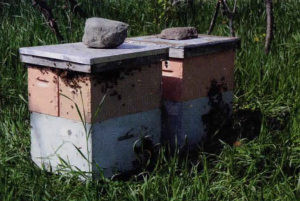
Brood factories
In the Spring, after the nucleus colonies had been transferred to the production yards, I always had some too weak to be of much use. Because my season is so short, these colonies never really built up in time to be productive. Trying to use what resources they held to benefit my operation, I combined the weakest, allowing them to grow until strong enough, and sacrificed them for making nucs. While this worked okay, it was far from perfect. Some years, for whatever reasons, they did not build up properly. This left me without enough brood and bees to make the planned increase, and forced me to sacrifice production colonies to make my nucs. Breaking up honey producers worked to provide me with the necessary resources for the work, but resulted in a decrease in the number of colonies. As a commercial honey producer, this was unacceptable.
One night while falling asleep, the thought came to me. Why not allow good overwintered nuclei to build up, use them as my brood/bee resource for making up the new nucleus colonies and leave the production colonies alone. In the Spring, I could expand them onto additional combs, and then harvest combs of brood and bees. What a game changer. The plan worked so well I decided to see how far I could take it.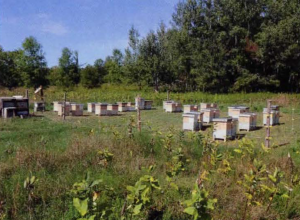
In the Spring of 2011, I set up 50 nice overwintered, four over four, two-story nucleus colonies in double nucleus boxes. Each nucleus was given a nucleus super with four additional combs, for a total of 12 combs each. Beginning in early May, I began removing sealed brood with adhering bees to strengthen my cell building colonies. Every four days, starting with the first nucleus, I removed two or three frames of brood from each nucleus until the day’s brood requirement was filled. Four days later, I repeated the process, harvesting brood from the nuclei next in line. My intention was to remove enough brood from each to fill my needs, but not enough to significantly weaken the colonies. I needed them to be strong enough to fill combs of brood quickly, but not so strong they would swarm before I returned for another harvest. From May 9 until June 19 I harvested 245 combs of brood to set up my 35 cell builders, each receiving seven combs of sealed brood and two of honey. Then, after the last cell builders had been set up, I switched the focus of my brood harvest to making the Summer’s nucleus colonies. Those 50 nuclei gave me enough additional combs of brood and bees to establish 330 more nucleus colonies. Think of it! More than 900 combs of brood and bees harvested from only 50 overwintered nucs.
Wintering nucleus colonies changed my beekeeping career forever. Back when I used to pollinate and keep bees using my old management, an average honey crop from 800 hives was something like 20 tons. I know that may sound like a lot of honey, but it is only a 50 pound average. When I started wintering my own nucs and raising my own queens, I had all these nucleus colonies in the Springtime and I did not have to split my bees to replace my losses. I did not have to buy any more bees and queens. I did not have to pollinate apples anymore! After only a few years of the new management plan, my average honey crop rose to 40 tons instead of 20, with a big crop being 50 plus tons instead of 30. And that is the difference. My bees are healthier and more productive. I have the resource in my nucleus colonies to build up my honey producers so they have a chance to make a good crop. My bees are stronger going into Winter and stronger coming out of Winter, and for those that do not make it? Well, I guess Wedmore had it right. That is what nucleus are for.
I never thought I would look at individual colonies in my apiary as being disposable. They were all ‘sacred cows’ to be preserved, come what may. I no longer feel the need to preserve every colony, or to give every queen just one more chance to prove herself. With a supply of nucleus colonies on the other side of the apiary, or down the road in an out apiary, I can afford to be ruthless. Unproductive colonies and poorly performing queens become completely disposable. My bees benefit, my apiaries benefit, and I benefit as well. And the same process benefits the bees when working on a much smaller scale.
While beekeeping is still agriculture and every year does not reward me with a big profit, I am having so much fun playing with my bees I doubt I will ever retire.










